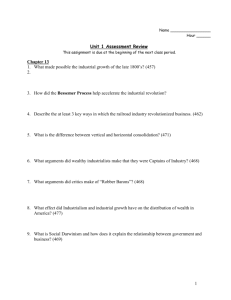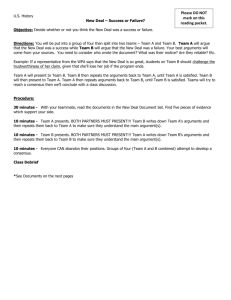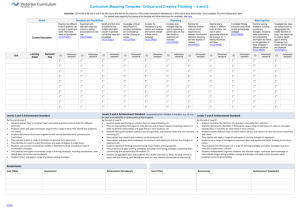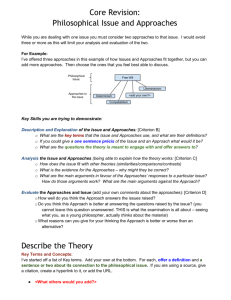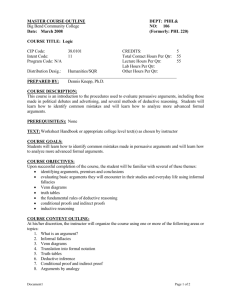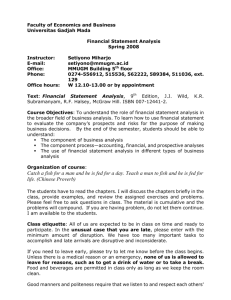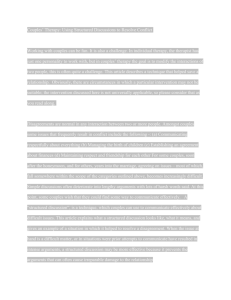File - Patricia Boling, Associate Professor of Political
advertisement
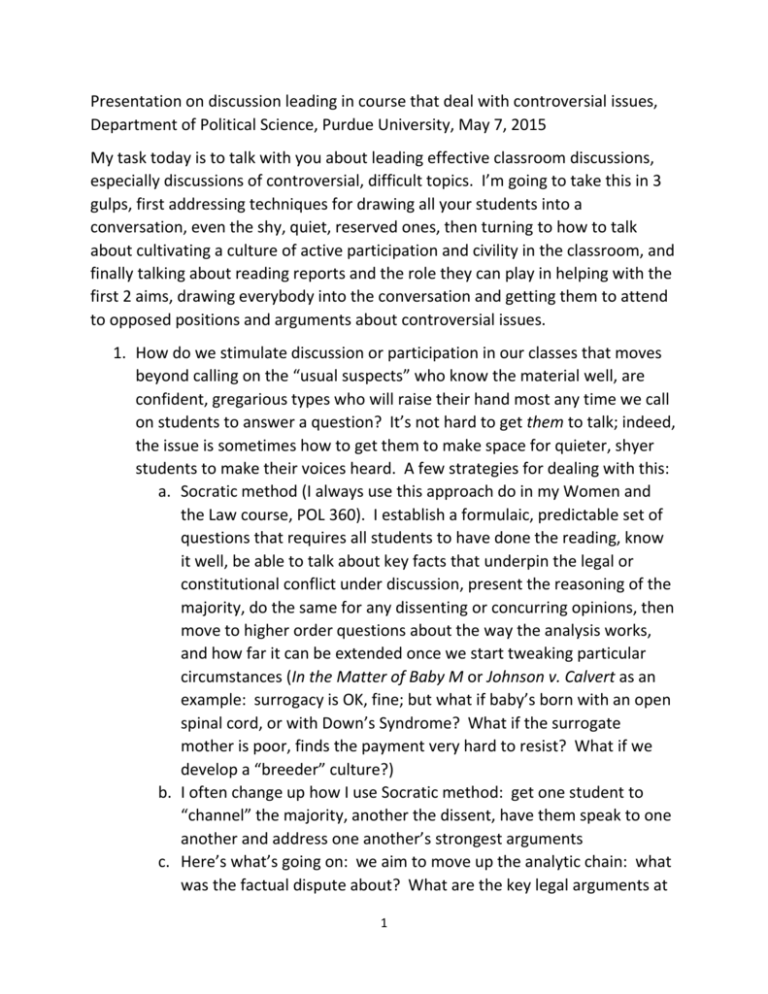
Presentation on discussion leading in course that deal with controversial issues, Department of Political Science, Purdue University, May 7, 2015 My task today is to talk with you about leading effective classroom discussions, especially discussions of controversial, difficult topics. I’m going to take this in 3 gulps, first addressing techniques for drawing all your students into a conversation, even the shy, quiet, reserved ones, then turning to how to talk about cultivating a culture of active participation and civility in the classroom, and finally talking about reading reports and the role they can play in helping with the first 2 aims, drawing everybody into the conversation and getting them to attend to opposed positions and arguments about controversial issues. 1. How do we stimulate discussion or participation in our classes that moves beyond calling on the “usual suspects” who know the material well, are confident, gregarious types who will raise their hand most any time we call on students to answer a question? It’s not hard to get them to talk; indeed, the issue is sometimes how to get them to make space for quieter, shyer students to make their voices heard. A few strategies for dealing with this: a. Socratic method (I always use this approach do in my Women and the Law course, POL 360). I establish a formulaic, predictable set of questions that requires all students to have done the reading, know it well, be able to talk about key facts that underpin the legal or constitutional conflict under discussion, present the reasoning of the majority, do the same for any dissenting or concurring opinions, then move to higher order questions about the way the analysis works, and how far it can be extended once we start tweaking particular circumstances (In the Matter of Baby M or Johnson v. Calvert as an example: surrogacy is OK, fine; but what if baby’s born with an open spinal cord, or with Down’s Syndrome? What if the surrogate mother is poor, finds the payment very hard to resist? What if we develop a “breeder” culture?) b. I often change up how I use Socratic method: get one student to “channel” the majority, another the dissent, have them speak to one another and address one another’s strongest arguments c. Here’s what’s going on: we aim to move up the analytic chain: what was the factual dispute about? What are the key legal arguments at 1 stake, and how does each side support their reasoning? How extendable are those arguments, when do they start to seem inadequate and why? What do you think the ruling in this case, or this hypothetical case should be, and why? 2. Let your students know that you value active participation and that you mean to establish a classroom where everyone’s ideas count and are heard. I let them know that one of the big pedagogic goals of this class is to have them become active, engaged thinkers who take a variety of positions and arguments seriously, figure out how to listen and hear one another’s ideas and positions, respond to them in a collegial manner (I underscore that it’s normal and OK to disagree, but we do so in an atmosphere of searching for more adequate thinking, approaches to problems that don’t have cut-anddried, single correct answers, that are fundamentally contested by citizens who are clear thinking, in search of fair, just, workable solutions to vexing issues. We don’t call others out, we don’t engage in ad hominem attacks, we don’t sneer, we listen respectfully and then we respond with our objections, critiques, counter arguments, etc). I tell my students early on “I want you to talk with one another, not just with me; I want you to build on the ongoing conversation that’s on the table on a particular day, not engage in professor-centric point scoring’ behavior. Think of the seminar as a dinner table, where conversations are multi-sided and sequential, and where you wouldn’t dream of stepping on another diner’s line while they’re still talking, or bringing up a brand new topic or idea without explaining what it has to do with what’s already under discussion.” a. Beyond Socratic Method: I often call on students (who raise their hands to volunteer an answer), but if I find that a few people dominate the conversation and others say nothing at all, I might explicitly solicit responses from the “strong silent types,” which gives the usual suspects the cue that they need to back off and create conversational space for quieter students b. Sometimes I use a little segue like “Well, don’t all talk at once!” when I ask a question that no one is responding to, using a jocular, teasing tone that still pushes them to answer. c. I recommend taking a little longer pause than feels quite comfortable (20 seconds seems like an eternity, but it’s not if you’ve asked them 2 to talk about something difficult, and they’re thinking about how to respond). d. I often give them a prompt, such as: “I’d like you to identify 3 passages that exemplify the argument that today’s author is making, & be prepared to point them out to the rest of us & explain why you think they’re key”; or “I want you to simply write for 3 minutes about the issues and questions that today’s reading posed, reacting off the top of your head & getting the juices flowing.” e. Sometimes I will have students work in 2s and 3s for 5 minutes, brainstorming or pursuing a specific task that can then be fed back into the larger classroom discussion f. Should participation count? Absolutely it should. If you’re teaching a seminar style class, this is the lifeblood of how to get good discussions going. Tell them it counts on your syllabus, and tell them how you go about evaluating their participation. Participation is not just showing up to class, though absence makes it impossible to participate, and a certain threshold of just showing up is crucial, and they should know that. I let them know that I keep tabs on who talks, the quality of what they say, and that at the end of the semester (and on the occasion of writing letters of recommendation) I look at my records of how much/how good their participation was in figuring out a score for their participation. It isn’t purely subjective; I can quantify how they did on several particular occasions when I called on them in POL 360, I can recall days when they were brilliant in reframing a question or rebutting another student’s argument. I always tell them their scores in time to speak with me about how they did at the end of the semester, and I invite them to check in with me any time during the semester they like about how they’re doing on this crucial dimension of course participation. 3. What about dealing with controversial issues? I don’t shy away from such issues, but I think they need to be dealt with carefully. Examples: abortion; affirmative action; surrogacy contracts; federal RFRA (the Hobby Lobby case); date rape; animal cruelty and CAFOs; industrial agriculture and issues 3 related to food insecurity, obesity, respect for farmers’ expertise, respect for approaches taken by ag economists, etc. a. Civility is key b. Invite them to play the devil’s advocate; indeed, require them to do so, and explain that they will never hold their positions the same way once they’ve had to take seriously the best arguments against them. c. Cultivate spirited disagreement, but never let it become personal, mean-spirited, or disrespectful. Let them know the emphasis is on respect, the notion that reasonable people might well disagree about issues such as these. Acknowledge that beliefs, values, political commitments are often personal and quite deeply held, visceral, and potentially divisive d. I tell my students that my job is not to convert them to my set of political values or perspective, but to make sure that they hold their own perspectives intelligently, know that making a good argument requires attending to counterarguments and positions that they don’t always agree with. e. Finally, consider using a version of the “purposeful reading report,” which asks students to identify key arguments, identify the perspective from which the author is writing (and who their audience is), and to formulate one good, solid question that they would ask the author if they could. I use such reports in conjunction with readings that traverse a variety of ideological perspectives, and use them as a way to get students used to taking on a variety of perspectives, and identifying their perspective, value orientation, audience, and persuasiveness. They work well for me: the students read carefully, checking the reports is not too time consuming or tedious for me, and the reports set up much more insightful and useful discussions of contested issues. 4


